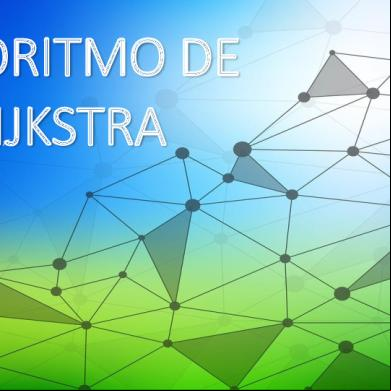Algoritmo Dijkstra En C 2r6m3q
This document was ed by and they confirmed that they have the permission to share it. If you are author or own the copyright of this book, please report to us by using this report form. Report 3i3n4
Overview 26281t
More details 6y5l6z
- Words: 1,393
- Pages: 5
EN PSEUDOCODIGO función Dijkstra (Grafo G, nodo_salida s) //Usaremos un vector para guardar las distancias del nodo salida al resto entero distancia[n] //Inicializamos el vector con distancias iniciales booleano visto[n] //vector de boleanos para controlar los vertices de los que ya tenemos la distancia mínima para cada w ∈ V[G] hacer Si (no existe arista entre s y w) entonces distancia[w] = Infinito //puedes marcar la casilla con un -1 por ejemplo Si_no distancia[w] = peso (s, w) fin si fin para distancia[s] = 0 visto[s] = cierto //n es el número de vertices que tiene el Grafo mientras que (no_esten_vistos_todos) hacer vertice = coger_el_minimo_del_vector distancia y que no este visto; visto[vertice] = cierto; para cada w ∈ sucesores (G, vertice) hacer si distancia[w]>distancia[vertice]+peso (vertice, w) entonces distancia[w] = distancia[vertice]+peso (vertice, w) fin si fin para fin mientras fin función ALGORITMO DE FLOYD Inicio Armar la matriz de adyacencia F, teniendo en cuenta que F(i,j)=0 si i = j (diagonal principal es 0). Además dónde no exista camino se debe indicar con infinito. Para k desde 1 hasta n Para i desde 1 hasta n Para j desde 1 hasta n F[i,j]=min(F[i,j], F[i,k] + F[k,j]) Fin para j Fin para i Fin para k En la k-esima vuelta F[i, j] contendrá el valor del camino más corto que una al vértice i con el j tal que dicho camino no pase por un vértice con número mayor que k. La matriz resultante es la de los mínimos caminos entre cada nodo. Si se quiere saber cual es dicho camino, se debe armar un árbol a medida tomando como numero de nodo a k cada vez que se detecta que hubo una optimización. //#include
cout << " =>Fk [" << (i+1) << ", "; cout << (j+1) << "] = " << F[i][j]; } cout << endl;}}} cout << "k = " << (k+1) << endl; mostrar(F);} } void mostrar(int F[N][N]) { int i,j; for(i=0;i
{p[i][j]=a[i][j]; }}} void path::disp() { //cout<<"The output matrix for the given graph is :"; for(int i=1;i<=n;i++) { for(int j=1;j<=n;j++) { cout<
<< " "; }cout<<endl;}} void path::pm() {int i,j,k; for(k=1;k<=n;k++) { for(i=1;i<=n;i++) { for(j=1;j<=n;j++) { p[i][j]=p[i][j] || p[i][k] && p[k][j]; }}}} void path::ap() { int i,j,k; for(i=1;i<=n;i++) { for(j=1;j<=n;j++) { p[i][j]=c[i][j]; }} for(k=1;k<=n;k++) { for(i=1;i<=n;i++) { for(j=1;j<=n;j++){ if(p[i][j]
del grafo por cada u en V[G] hacer distancia[u] = INFINITO padre[u] = NULL Añadir(cola,
) distancia[s]=0 mientras cola != 0 do // OJO: Se entiende por mayor prioridad aquel nodo cuya distancia[u] es menor. u = extraer_minimo(cola) //devuelve el minimo y lo elimina de la cola. por cada v adyacente a 'u' hacer si ((v ∈ cola) && (distancia[v] > peso(u, v)) entonces padre[v] = u distancia[v] = peso(u, v) Actualizar(cola,
ALGORITMO DE KRUSKAL
function Kruskal(G) for each vertex v in G do Define an elementary cluster C(v) ← {v}. Initialize a priority queue Q to contain all edges in G, using the weights as keys. Define a tree T ← Ø //T will ultimately contain the edges of the MST // n es el número total de vértices while T has fewer than n-1 edges do // edge u, v is the minimum weighted route from/to v (u,v) ← Q.removeMin() // previene ciclos en T. suma u, v solo si T no contiene una arista que una u y v. // Nótese que el cluster contiene más de un vértice si una arista une un par de // vértices que han sido añadidos al árbol. Let C(v) be the cluster containing v, and let C(u) be the cluster containing u. if C(v) ≠ C(u) then Add edge (v,u) to T. Merge C(v) and C(u) into one cluster, that is, union C(v) and C(u). return tree T #include





